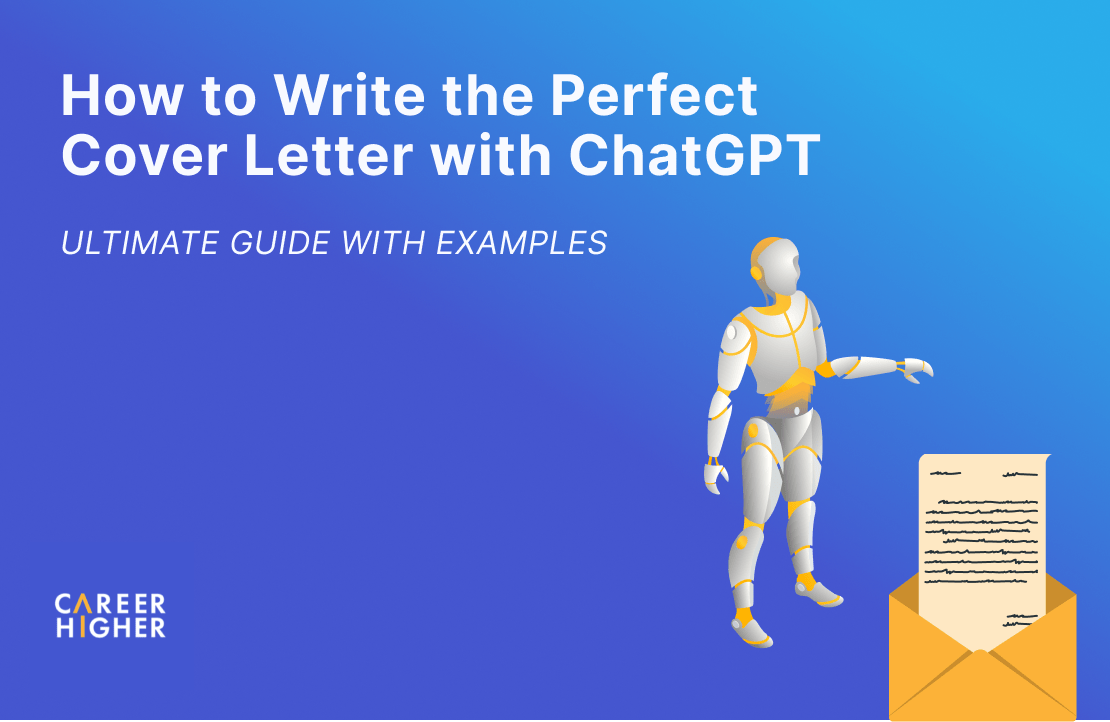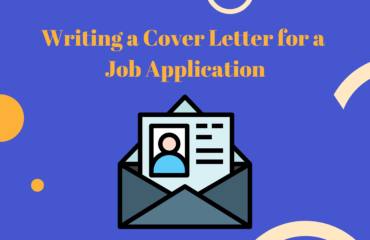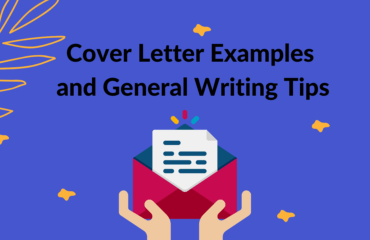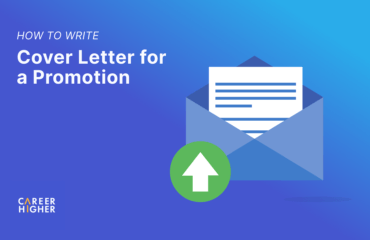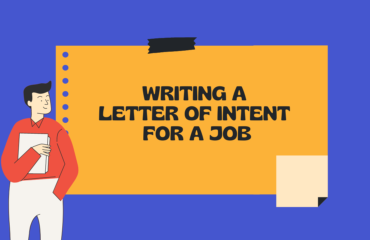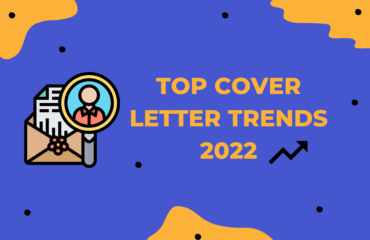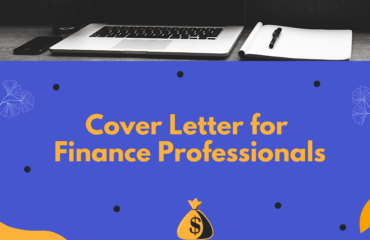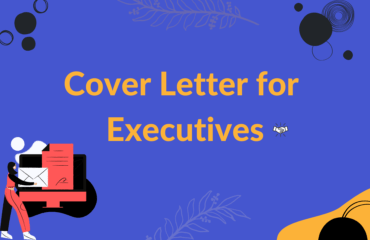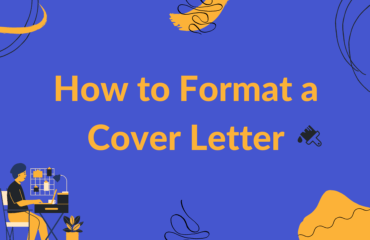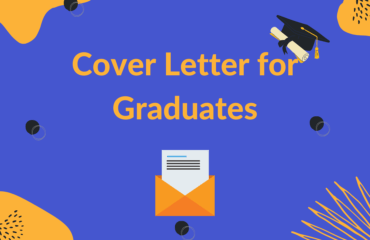Table of Contents
- Why should you use ChatGPT to write a cover letter?
- Can you only rely on ChatGPT to write your cover letter?
- Structuring your cover letter
- How to use ChatGPT to write different cover letter sections
- Strategies for optimizing ChatGPT’s output
- How to use ChatGPT for cover letter writing: bonus prompts
- What are some common pitfalls to avoid while using ChatGPT for cover letter writing?
The job search process can be tedious and challenging. You have to draft a standout resume, set up an impressive LinkedIn profile, write a compelling cover letter, and reach out to employers until you secure an interview opportunity. We understand how overwhelming everything can be! With the help of ChatGPT, you can optimize some aspects of your job search, such as writing an effective cover letter that grabs the attention of the potential employer so that you can focus on other strategic steps. In this guide, we’ll walk you through how you can leverage ChaGPT to craft a cover letter that lands you in your dream role.
Why should you use ChatGPT to write a cover letter?
Before you start using the AI tool, it’s a good idea to understand how ChatGPT can help you in the cover letter writing process. Here are some key advantages of using ChatGPT:
a) Inspiration: If you aren’t naturally creative or experiencing writer’s block, ChatGPT can prove to be an incredibly valuable resource. It can provide valuable suggestions on what content to include in your cover letter, how to phrase your sentences, and how to structure your document, among other things.
b) Time-saving: Using ChatGPT can help you save a lot of time and effort when it comes to writing tasks. By analyzing job postings, offering personalized suggestions, and optimizing content, ChatGPT can help you save hours of manual work.
c) Unlimited revisions: ChatGPT allows unlimited revisions of your cover letter until you reach an outcome you are happy with. It allows you to explore multiple prompts, experiment with different approaches, and ask for suggestions until you reach the desired results.
d) Free to use: ChatGPT is currently available in both free and paid versions. Although the paid version offers better performance, the free version remains an excellent choice, particularly for job seekers on a limited budget. It’s a cost-effective tool that empowers job seekers to craft compelling cover letters without financial constraints.
Can you only rely on ChatGPT to write your cover letter?
While ChatGPT can greatly help your job application process, it’s important to remember that you shouldn’t solely rely on it. As an AI technology, ChatGPT lacks the personalization and human touch necessary to make you stand out from the competition. The AI model doesn’t possess a genuine understanding of the job requirements, your motivation for applying, your unique experiences, and your background in a way that a human would understand. Writing a compelling cover letter entails capturing emotional nuances, a skill that the system lacks. Thus, while it serves as a great supplementary tool to aid your job search, remember it can’t substitute the expertise of a qualified career expert.
Structuring your cover letter
Before writing your cover letter, it’s important to develop a well-defined structure that effectively conveys the right message to the reader in a clear and compelling manner. Typically, the cover letter is composed of four key sections, each serving a distinct purpose. Here is an overview of each section:
a) Header and contact information: In the header section, we suggest including your full name, job title, and contact information (mailing address, phone number, professional email address, and LinkedIn profile link). If applicable, you may also include a link to your personal webpage or online portfolio to provide additional context and showcase your work.
b) Salutation: Next, include a greeting for the recipient of your cover letter. If you know the name of your hiring manager, you could use a formal salutation followed, addressing them by their first name. However, if you are unsure of the hiring manager’s name, you can opt for a generic greeting such as “Dear Hiring Manager.”
c) Cover letter body: This section is the crux of your cover letter. Here, you introduce yourself, demonstrate why you’re the perfect fit for the position, express your interest in the position and company, and how you can add value. It should consist of no more than five paragraphs to maintain conciseness and readability.
d) Complimentary close: Close with a professional sign-off like “Yours sincerely” or “Yours faithfully”.
How to use ChatGPT to write different cover letter sections
Now that we have understood the structure of an effective cover letter, let’s explore how we can leverage ChatGPT to create different resume sections in this section.
1) Write an attention-grabbing introduction
Creating a strong first impression is crucial as it sets the tone for your cover letter. In the opening paragraph, it is important to catch the hiring manager’s attention and convince them to read further. In a few sentences, briefly introduce yourself and how you’ll add value to the company. To guide ChatGPT in generating an impactful introduction, provide the AI tool with the necessary information about yourself, the source of the job posting, the job title and the company, and your enthusiasm for the specific job position. Here is an example of the prompt:
Prompt: Write an engaging introduction for a cover letter for a <mention job title> at < mention company>, <mention relevant experiences>, <state where you found out about the job>. Emphasize enthusiasm for the company’s <mention company’s core focus>.
Now let’s see an example of the prompt in action:
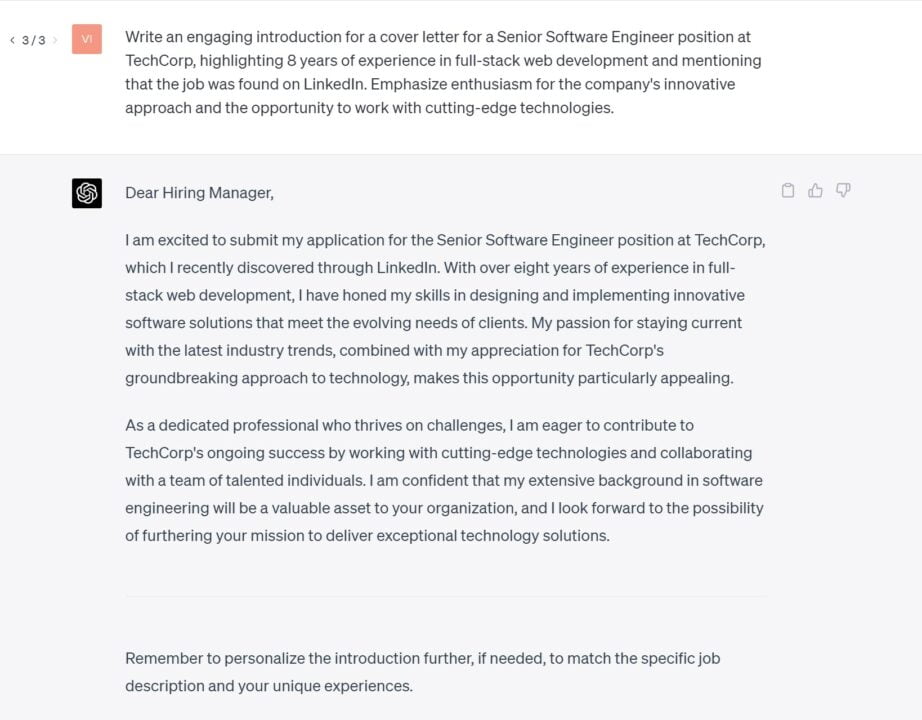
Remember to use the output generated by ChatGPT only as a starting point. You should edit and personalize the content further to align it with your unique circumstances. For instance, in the above output generated by ChatGPT, the introduction is longer than we typically recommend, indicating the need for further editing to ensure conciseness and clarity.
2) Showcase relevant skills and achievements
The next two paragraphs are the meat of your cover letter. You need to emphasize your relevant skills and achievements to showcase to your potential employer you have what it takes to succeed in the specific job role. In your prompt, provide details about your job role, specific achievements, and what sets you apart from other candidates. To enhance the accuracy and relevance of the generated responses, you may consider sharing your resume and the job posting with ChatGPT. Here’s a sample prompt you can use as a starting point.
Prompt: Write a cover letter body for <mention job role> at <mention company name>, focusing on my relevant experiences and skills <paste experiences>. Emphasize my achievements of <mention key achievements with quantifiable metrics> that align with the job posting. Include examples of situations wherein I demonstrated leadership or problem-solving skills.
Here is my resume <paste resume>
Here is the job posting <paste job description>
Here is an example of the output generated by ChatGPT using the above prompt:
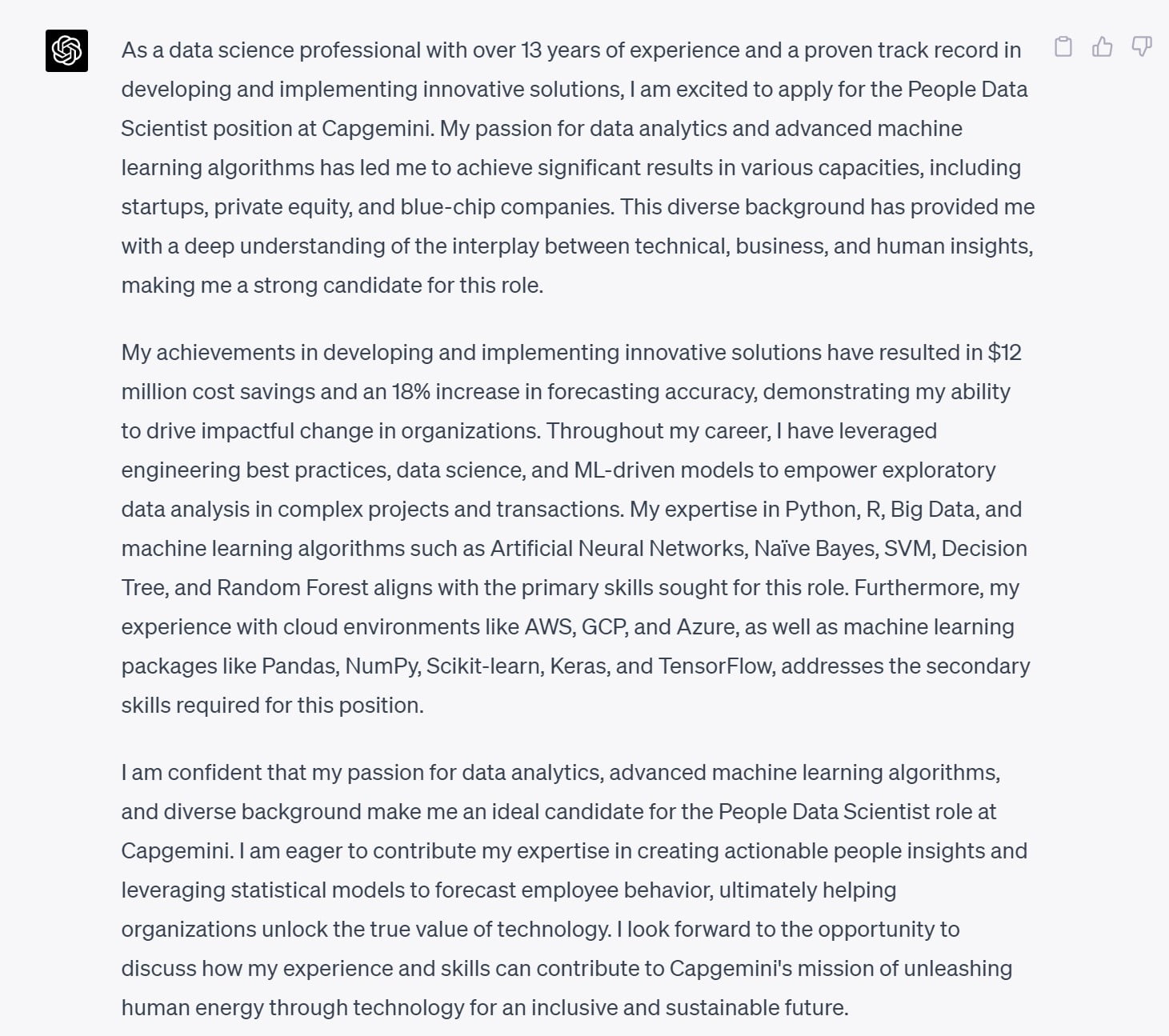
Note, while the above output provides a great starting point for your cover letter, it lacks the cohesiveness and storytelling typically found in a human-written cover letter. ChatGPT also regurgitates some points from the resume. To further refine the output, you can follow up with ChatGPT using additional prompts to guide its responses regarding the desired tone, voice, optimal paragraph length, and specific examples to highlight. We also strongly recommend using the output as a foundation and infusing it with your own writing style and storytelling. This approach will result in a cover letter that is truly reflective of your unique qualities and effectively communicates your professional narrative.
3) Demonstrate your fit for the company
In the fourth paragraph of the cover letter, we recommend demonstrating why you are the ideal fit for the specific employer. To do so, it is important to describe why you want the job and your motivation for working for the particular employer. Thus, you need to learn more about the organization and get a better idea of its mission, goals, and accomplishments.
You could take ChatGPT’s help to conduct research about a particular company, however, we recommend not relying on it solely. We suggest supplementing ChatGPT’s research with your own to gather the latest and most accurate information. Here is a prompt you could use for this paragraph:
Prompt: Write a short paragraph for a cover letter, consisting of 5-6 lines, demonstrating my interest in <job title> at <company name>. Focus on expressing my enthusiasm for working at the company.
Here are some noteworthy achievements and news about the company are <paste as per your research>
Here is my resume <paste resume>
Here is the job posting <paste job posting>
Here is an example of the results generated by ChatGPT:
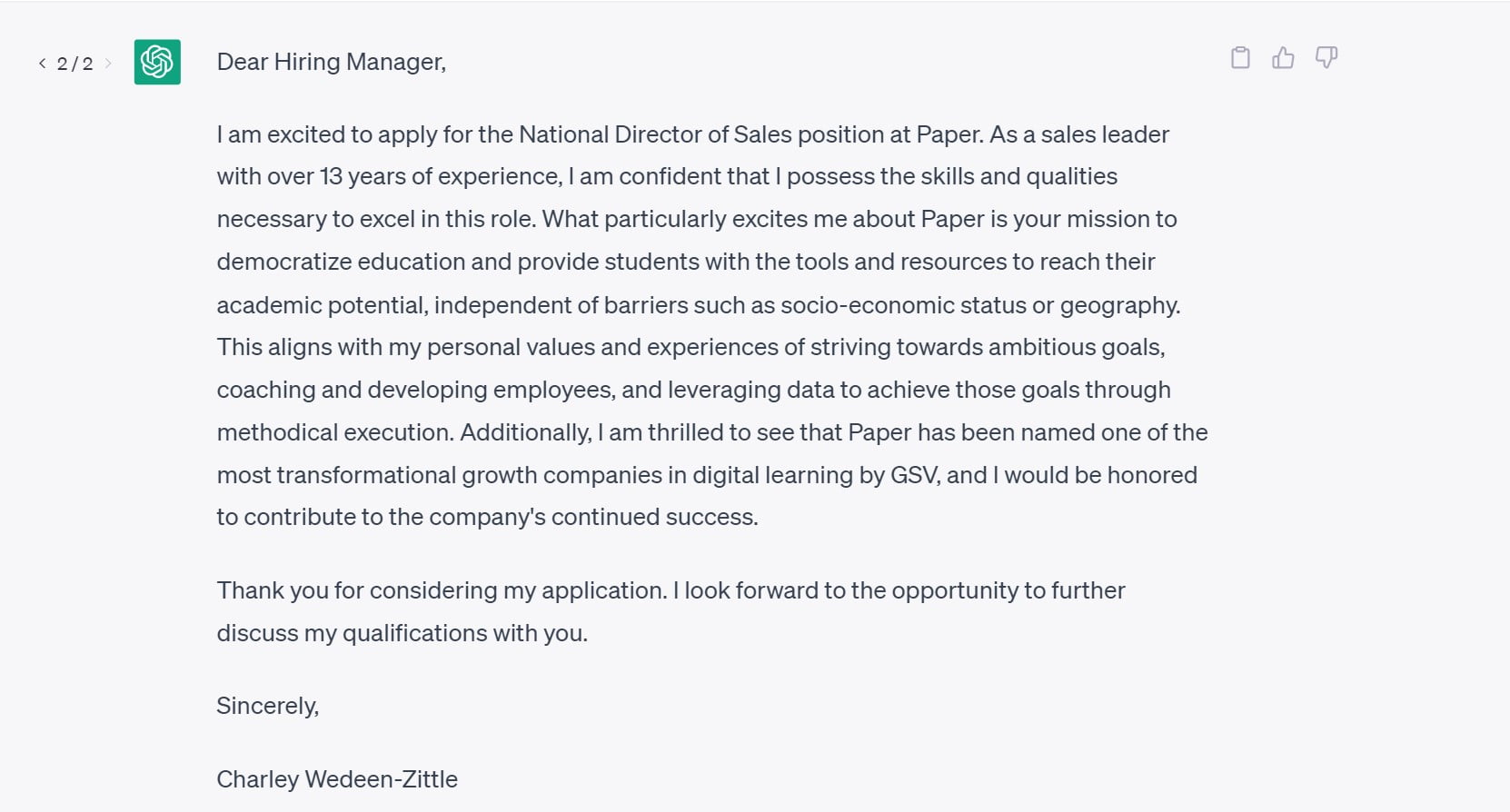
4) Close-out professionally
It is important to close the cover letter in a polite and professional manner. In the closing statement, remember to summarize what you have to offer, express gratitude to the hiring manager, and add a call to action and a complimentary close. Here is a prompt you can use:
Prompt: Write the closing statement for a cover letter for <job title> at <company name>. Summarize what I have to offer, express my gratitude for considering my application, invite further discussion, and include a complimentary close. Keep it concise, professional, and impactful.

Strategies for optimizing ChatGPT’s output
To make the best use of ChatGPT, it is important to use the right tactics to obtain the best results. In the following section, we’ll explain a few strategies that can help you tailor ChatGPT’s output to suit your requirements better:
a) Structure your cover letter format: When it comes to cover letters, we recommend following a conventional cover letter format, with a contact information section, a formal greeting, three to four body paragraphs, and a concluding statement. While ChatGPT can suggest cover letter formats, it’s important to keep in mind that they may not always align with the conventional cover letter structures. To ensure you present your experiences and qualifications in a clear and organized manner, we suggest creating your own cover letter format.
b) Try experimenting with the prompts: Even small changes in prompts can greatly impact ChatGPT’s output. Try out different prompts and see which one yields the most effective results. You could also use ChatGPT for multiple versions and choose what works best for you.
c) Always proofread: ChatGPT may occasionally produce inaccurate or false information. Thus, we strongly recommend fact-checking the results generated by ChatGPT to ensure it is accurate and relevant. Also, it’s a good idea to review the document for grammar, spelling, and clarity before submitting it.
d) Use examples: Provide ChatGPT with examples of sentences or phrases you would like to include in your cover letter. This will enable the AI tool to incorporate your desired language, tone, and style and meet your expectations more effectively.
How to use ChatGPT for cover letter writing: bonus prompts
1) Tailoring your cover letter for different job postings
Cover letters should be tailored to the specific job and the company you’re applying to. However, customizing your cover letter for each job application can require a lot of time and effort. ChatGPT can help you streamline this process.
Here is a ChatGPT prompt to help you tailor your cover letter to different job applications:
Help me tailor the following cover letter for the job role <insert job title> at <insert company name>
Here is the job description <paste job description>
Here is information about the employer <paste findings as per research>
Here is my current cover letter <paste cover letter>
2) Tailoring voice, language, and tone
Some job applicants believe that the voice, tone, and language of a cover letter should be strictly formal. However, this is not always true. The style of writing should match your target employer’s culture, industry, and environment. We suggest researching the target company’s website better to gauge their voice, style, and values and mimic the same tone in your cover letter.
Here is a ChatGPT prompt to help you match the language and tone of your cover letter with the target employer:
Help me write a cover letter that matches the tone and language of my target role, employer, and industry while maintaining an optimistic and enthusiastic tone throughout the letter.
My target role is <mention job role>
My target company is <mention target employer>
My target industry is <mention target industry>
My key suggestions about the employer’s tone are: <paste observations as per research>
3) Addressing employment gaps
While you may feel hesitant, we strongly encourage addressing your employment gaps in your cover letter. By doing so, you can clear any reservations your potential employer may have about your employment history. Remember to be upfront and honest, give a brief reason, and highlight new skills and experiences gained during the gap.
Here is a ChatGPT prompt to help you address employment gaps in your cover letter:
Help me in explaining my employment gap of <mention length of the gap> in my cover letter for <job position> at <mention company name>. During this time, I <specify what you did, e.g., appeared for exams, volunteered, freelanced, etc>. Explain how the skills and experiences I gained during the gap are relevant to the role.
4) Explaining relocation
When considering a relocation for a new job, it is crucial to dedicate extra attention to crafting a persuasive cover letter that effectively demonstrates your unique qualities and sets you apart from local candidates. In your cover letter, we suggest mentioning why you’re considering the move and your keenness for working with the particular company.
Here is a ChatGPT prompt to help you explain relocation in your cover letter:
Help me craft a compelling relocation cover letter for <mention job title> at <company name>. I am looking to relocate to <mention new city or region> for <specify reasons for relocating>. In the cover letter, address my professional interest in relocating to <mention new city or region>. Focus on my adaptability and enthusiasm for the opportunity and explain how my experience and skills can contribute to the company’s growth.
What are some common pitfalls to avoid while using ChatGPT for cover letter writing?
When using ChatGPT for writing your cover letters, it’s important to be aware of common pitfalls to avoid. Here are some key points to keep in mind:
a) Over-reliance on the tool: Although AI may provide valuable suggestions, you shouldn’t rely on ChatGPT solely when writing your cover letter. Be sure to bring in your own voice and create content based on personal experiences and unique perspectives.
b) Don’t just stick to your resume: Cover letters are a great place to tell your story and let your personality shine. Remember to share specific details and well-thought-out personal anecdotes that connect with the reader in your ChatGPT prompts. An effective cover letter doesn’t repeat the resume and is hyper-specific to the role you’re targeting.
c) Make informed choices: On the internet, you’ll likely find articles that claim to offer tried and tested prompts for creating quick exceptional cover letters using ChatGPT. We suggest approaching these sources with caution. While these articles may provide some valuable insights, it’s important to use your own judgment and recognize that creating a compelling cover letter requires effort and personal attention.
d) Avoid lengthy cover letters: ChatGPT may yield lengthy responses, so it’s important to refine the generated output yourself. You could mention the desired length in your ChatGPT prompts, but the AI tool may not always adhere to these instructions. Thus, we suggest using ChatGPT as a valuable starting point, but not as a definitive solution. Highlight your key experiences, skills, and qualifications, and aim for a concise and targeted cover letter. Ideally, your cover letter should fit one page.
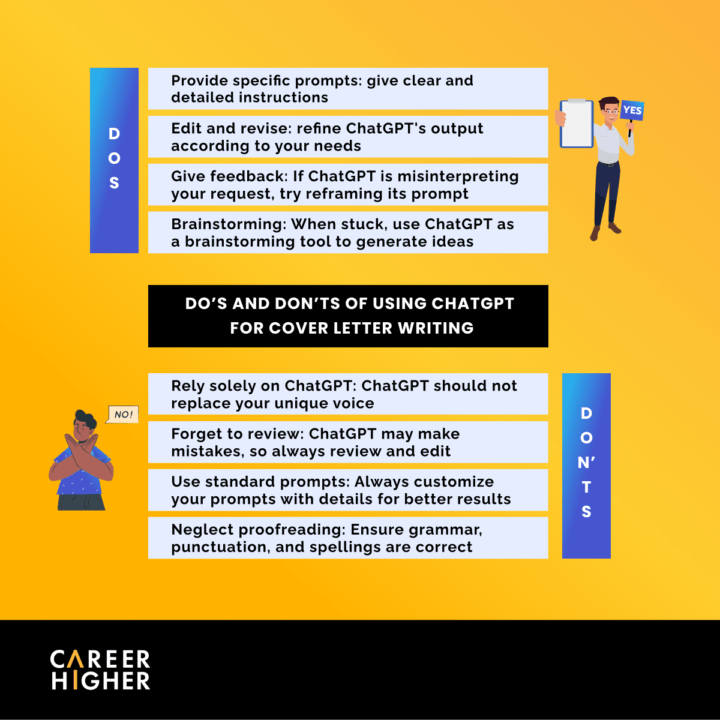
There has been a significant debate on whether ChatGPT should be used to create job application documents, and if recruiters would penalize AI-generated cover letters. While AI technology can help you get your creative juices flowing, remember to always bring your own voice and personalize the cover letter to stand out amongst other candidates. If you’re looking for expert human assistance in the job search process, we are here to help. Feel free to reach out to us.
